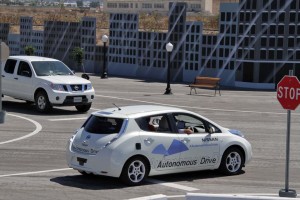
A prototype Nissan Leaf autonomous vehicle negotiates a simulated urban intersection, complete with cross traffic.
After a brief surge last year, federal data show that highway deaths are again on a sharp decline, falling an estimated 4.2% during the first half of this year. And while an ongoing crackdown on drunk driving is one factor for the 40% decline in fatalities over the last four decades, improved vehicle design and advanced safety hardware also are getting much of the credit.
That’s led the National Highway Traffic Safety Administration to encourage the industry to fast-track new technical advances that many experts now believe could eventually lead to an era of zero fatalities.
“Safety is our top priority and we can achieve remarkable progress in reducing injuries and fatalities in this era of innovation and technology,” proclaimed Transportation Secretary Anthony Foxx, who is asking for “real solutions that can significantly address safety issues that have plagued this nation for decades,” as part of NHTSA’s new “Significant and Seamless” initiative.
For years, the auto industry resisted pressure from the government to add technologies that could, in turn, add to vehicle costs. But finding that consumers are as anxious as government regulators to get safer vehicles, that resistance has been rapidly melting away. It helps that private organizations like Consumer Reports and the Insurance Institute for Highway Safety (IIHS) now track and rate the safety of individual vehicles – from crash test results to the effectiveness of collision prevention devices.
(US traffic deaths fall sharply for first half of 2013. Click Here for full details.)
Honda is one of those manufacturers that agrees technology can play a critical – and perhaps the single most important – role “to create a zero-collision environment,” the head of technical development at the maker’s main R&D center in Tochigi, outside Tokyo.
Other manufacturers, including Volvo, long known as a leader in safety technology, have gone as far as to predict it possible to cut roadway deaths to zero.
NHTSA first began calling for safety technology nearly a half-century ago, initially with basic systems such as seatbelts and new vehicle designs meant to better absorb impact forces during a crash. But with the mandate for airbags in the late 1980s, the push for smarter technologies ramped up. Today, automakers are required to not only use so-called passive safety systems – which reduce the risk of injury in a crash – but to build in active safety technologies meant to prevent a crash in the first place, such as electronic stability control.
(Safety features can land a motorist big insurance discounts. Click Hereto find out more.)
The government’s top automotive safety agency could take things several steps further. A year ago, the National Transportation Safety Board called for new rules requiring even more advanced collision-avoidance technologies, such as blind spot warning systems and forward-looking radar, on every car.
That has been backed by the trade group, the IIHS, which recently issued its first study ranking the various forward collision-avoidance systems, some of which can bring a vehicle to a complete halt if a vehicle, pedestrian, even a large animal, poses the risk of a crash.
Such technologies are still expensive and the industry is still cautious about adding these features across the board, fearing that entry-level buyers, in particular, could be priced out of the market. But proponents insists that, as with consumer electronics, costs are coming down as production volumes increase.
(More than half of new child seats score a top ranking. Click Here for more.)
The “Significant and Seamless” initiative “challenges both the automotive industry and the agency to determine the extent of, and ultimately utilize, the significant safety potential in these areas,” said NHTSA.
How far industry researchers can take these new technologies remains to be seen, but several automakers, including Nissan, Honda and General Motors, have expressed a desire to have their first autonomous vehicles in production by decade’s end.
It’s not expected that self-driving cars will take over the market, at least not initially, but many of the basic features that will make autonomous driving possible are already showing up in today’s vehicle’s, especially luxury cars like the 2014 Mercedes-Benz S-Class. The new NHTSA initiative will challenge manufacturers to push those safety features into the mainstream.

While tech has certainly improved safety, there will never be a time of zero fatalities when you have moving objects. Crash protecting tech will reduce crashes and injuries further but at a cost to all. It’s interesting to note that insurance rates have not dropped to match the 40% reduction in fatlities and injuries…